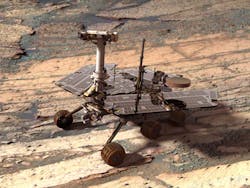Opportunity Rover’s Findings Point to Microbial Life on Mars
In its 10th year on Mars, NASA’s Opportunity rover has confirmed the existence of an ancient wet environment. That environment is both milder and older than previously thought. Opportunity’s team, including Deputy Principal Investigator Ray Arvidson, calls the latest evidence “landmark” and hopes this better understanding of Mars will help to advance plans for human missions in the 2030s.
The rover is currently examining the rim of the Endeavour Crater, having driven 24 miles from where it originally landed on January 24, 2004. NASA’s Jet Propulsion Laboratory (JPL) in Pasadena, Calif. scanned the ground for promising rocks in the area of Endeavour’s rim, which is called Matijevic Hill. In 2010, evidence of a clay mineral known as iron-rich smectite was detected by a mapping instrument (called the Compact Reconnaissance Imaging Spectrometer for Mars). The goal is to examine the mineral in its natural context to pinpoint where it is found and how it is situated with other minerals. Researchers believe the wet conditions that produced the smectite preceded the development of the Endeavor Crater four billion years ago.
Michael Meyer, lead scientist for NASA’s Mars Exploration Program, says, “This gives us greater incentive to continue seeking evidence of past life on Mars.” Although the Opportunity rover was only intended for a three-month mission, the vehicle is still capable of performing its duties for the scientists and engineers who plan each day’s activities on Mars. In addition to Opportunity, Spirit (its twin, which worked for six years) and their successor, Curiosity, have supplied information about the diverse watery environments of a past Mars.
About the Author
Sarah Mangiola
Sarah Mangiola has written on many different topics within Penton's Design, Engineering, and Sourcing Group. Originally from California, she graduated from the University of California, Davis with a B.A. in political science.
